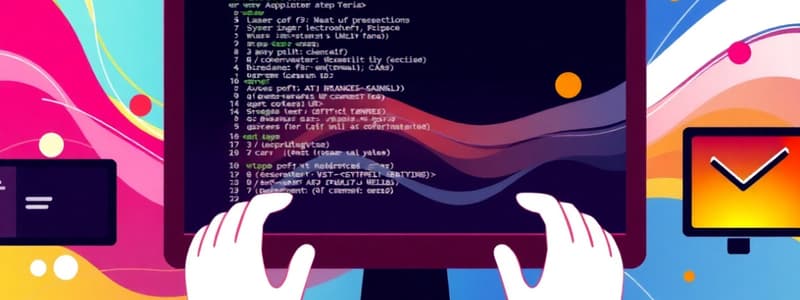Podcast
Questions and Answers
Which phase of application development involves documenting functional requirements and anticipating potential challenges?
Which phase of application development involves documenting functional requirements and anticipating potential challenges?
- Testing
- Analysis (correct)
- Design
- Planning
Web applications generally do not require internet connectivity, as they are designed to function offline.
Web applications generally do not require internet connectivity, as they are designed to function offline.
False (B)
In application development, what is the primary purpose of the Testing phase?
In application development, what is the primary purpose of the Testing phase?
Ensure app functionality works as expected
The continuous monitoring and updating of an application based on user feedback is referred to as ______.
The continuous monitoring and updating of an application based on user feedback is referred to as ______.
Which type of application combines aspects of both web and mobile applications, potentially accessible via a browser or as a downloaded app?
Which type of application combines aspects of both web and mobile applications, potentially accessible via a browser or as a downloaded app?
Match each emerging technology with its correct description:
Match each emerging technology with its correct description:
Which of the following is an example of a Virtual Reality (VR) technology?
Which of the following is an example of a Virtual Reality (VR) technology?
Cross-platform development involves writing separate codebases for each platform (iOS, Android, Web) to ensure optimal performance.
Cross-platform development involves writing separate codebases for each platform (iOS, Android, Web) to ensure optimal performance.
Flashcards
Application Development
Application Development
The process of planning, designing, and deploying a software application.
Planning (App Dev)
Planning (App Dev)
Determining the application's purpose and the problem(s) it will solve.
Analysis (App Dev)
Analysis (App Dev)
Documenting functional requirements and anticipating challenges.
Design (App Dev)
Design (App Dev)
Signup and view all the flashcards
Construction (App Dev)
Construction (App Dev)
Signup and view all the flashcards
Testing (App Dev)
Testing (App Dev)
Signup and view all the flashcards
Implementation (App Dev)
Implementation (App Dev)
Signup and view all the flashcards
Support (App Dev)
Support (App Dev)
Signup and view all the flashcards
Study Notes
- Application Development refers to the process of planning, designing, and deploying a software application.
Scope of App Dev:
- Planning involves identifying the application's use case and the problems it will solve.
- Analysis includes documenting functional requirements and anticipating challenges.
- Design defines the application's operation and features.
- Construction involves programming the application's features.
- Testing ensures the app and its functionality work as expected.
- Implementation makes the application available to users.
- Support involves continuous monitoring and updating based on user feedback.
Types of Applications:
- Web Applications are accessed via a browser, require internet connectivity, and are served by a server using HTTP/HTTPS protocols.
- Examples include Google Docs, IAccess, and LSPUOnline.
- Mobile Applications are designed for mobile devices and often can be used offline.
- Examples include Instagram, TikTok, and Shopee.
- Desktop Applications can be directly downloaded on personal computers or laptops.
- Examples include Photoshop, Blender, and Office 365.
- Hybrid Applications combine aspects of web and mobile apps, accessible through browsers or direct download.
- Examples include Twitter, Facebook, and PWAs.
Overview of Emerging Technologies:
- Internet of Things (IoT) involves devices connected via the Internet to communicate with each other.
- Examples include Smart Fridges and Smart Homes.
- Artificial Intelligence (AI) uses machine learning algorithms to mimic human intelligence.
- Examples include Chatbots, Speech Recognition, and ChatGPT.
- Augmented Reality (AR) combines the real world environment with digital overlays.
- An example is Pokemon GO.
- Virtual Reality (VR) provides a fully immersive digital environment.
- An example is Oculus Rift.
- Blockchain is a decentralized digital ledger allowing for private and encrypted transactions.
- Examples include Crypto, Bitcoin, and Doge.
Trends in Cross-Platform Development:
- Cross-Platform Development allows development for multiple platforms (iOS, Android, Desktop, macOS, Web) with a single codebase.
- It reduces development time and enhances user experience across devices.
- Frameworks include Flutter and React Native.
- Increased Focus on User Experience (UX) involves developers focusing on intuitive interfaces and seamless user interaction for increased user satisfaction.
- Integration of AI Features allows applications to integrate AI for a personalized user experience.
- Examples include Chatbots for Support and Recommendation Systems.
Studying That Suits You
Use AI to generate personalized quizzes and flashcards to suit your learning preferences.




